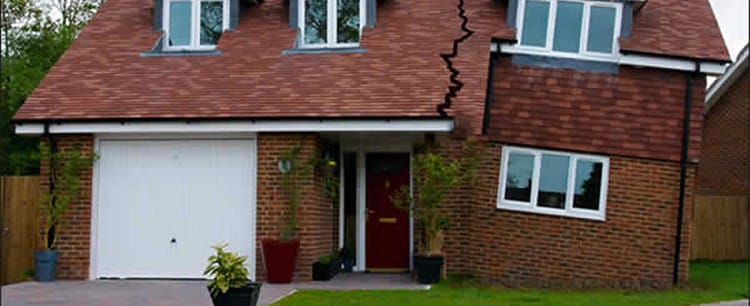Subsidence Claims
Subsidence claims are typically amongst the most expensive home insurance claims. Problems arising from subsidence may be difficult to spot and develop only over a number of years. Making repairs and finding remedies are also likely to be expensive, which is why some home insurance policies may exclude cover for subsidence and why those can cost at least a £1,000 – £5,000 excess on each claim. What areas are homes most likely to be at risk?
Risk areas
Risk of subsidence is commonly attributed to a number of factors, some of which may stand up to closer scrutiny, but some which might also be based on popular misconceptions:
Soil types
- A home might be affected by subsidence in practically any area of the country
- Geobear created a map of all subsidence hotspots in the UK
- Areas that are predominantly clay, sandy or chalky soils are said to contribute to unstable conditions for the foundations of buildings
- Soil conditions alone are rarely the cause for subsidence
- There is some evidence that shows a recent spell of long, hot, dry summers can contribute to soil shrinkage across predominantly clay soils
Trees and large shrubs
- Trees and large shrubs growing in close proximity to the building can cause subsidence
- Oaks, poplars, and willows, have long root structures of 30 metres or more
- The absorption of water by the roots steadily shrinks the surrounding soil and this may lead to the collapse of the foundations of a building
Soil shrinkage is responsible for 75% of all instances of subsidence, according to Subsidence Support;
Building standards
- Recent years have seen an increase in the number of extensions built in the UK
- Not all of these works have been to the highest building standards and inadequate or poorly-prepared foundations on unsuitable ground may be contributing to the recent spate of subsidence claims
Blocked and collapsed drains
When drains to your home become blocked or suffer a collapse, the accumulation of groundwater may be sufficient to wash away the ground supporting the foundations – especially if your home is built on lighter, sandy or chalky soils.
Subsidence is a problem which may develop over a number of years but in an uneven and irregular manner. Some years, for instance, further settlement may seem to have stabilised, only to recur once again when weather conditions also change – bringing either prolonged periods of drought or flooding.
It is these changes which may have contributed to the recurrence of subsidence problems and the current upsurge in the number of related insurance claims.
What to do if you want to change insurers but you have an existing claim
If you know that property you own already has, or may have, subsidence issues, it might not seem to be a good time – or even possible – to switch insurers.
Since your precise needs and insurance deals are changing all of the time, this is likely to be frustrating if you have spotted a policy that better serves your purposes or is more competitively priced.
The goods news is that certain insurers have agreed to handle claims arising from cases where you have recently switched home insurance policies.
The handling of such claims is detailed in guidelines published by the Association of British Insurers (ABI).
The insurer responsible for handling your claim and making any settlement depends on the exact timing of the switch:
Less than 8 weeks after your switch
If you switch your subsidence insurance less than 8 weeks ago, your previous, original home insurer agrees to handle your claim and to bear the costs of any settlement;
More than 8 weeks, but less than a year
You may make your claim either to your original insurer or the new one and each will keep the other informed about its handling and agree to share the costs of any settlement – the one insurer is obliged to make its half-share contribution to the other within 21 days;
More than one year after your switch
Any claims on your subsidence insurance that need to be made after you have switched insurers need to be made to your new insurer.
Agreement between the respective insurers
Participating insurers agree to share with each other all the documents relating to your claim – including reports from loss adjusters, surveyors, engineers, and others, so that the necessary reserve is made in anticipation of settling the claim or making the relevant contribution to the settlement of the claim.
The participating insurer who is obliged to contribute to the settlement agrees to abide by the way in which the insurer handling your claim investigates it and agrees to settle it.
If you raise any dispute in relation to the handling of your subsidence claim or its settlement and refer the matter to the Insurance Ombudsman, the contributing insurer agrees to be bound by the Ombudsman’s decision and to make the relevant contribution accordingly.
Arranging subsidence insurance
Even though you might have a subsidence history claim, that is no reason to put off reviewing and, if necessary, switching to an alternative insurer.
Just as your precise insurance needs and requirements change over time, so do the insurance products on offer. Rather than simply repeating last year’s policy at each renewal date, it almost certainly pays you to review your existing cover, compare the extent of protection offered by other insurers, and of course, consider whether you might achieve the same level of protection at a cheaper price.
Here at UKinsuranceNET, our mission is to help you do just that. Since the insurers we are likely to recommend are also signatories to the ABI’s agreement on the handling of subsidence claims, you may rest assured that any subsidence issues that arise after you make a switch will continue to be handled either by your original insurer, your new insurer, or the two of them working together.
Subsidence Disputes as a Landlord
As a buy to let landlord, you invested in property by way of a business proposition to generate income from the rents collected from your tenants.
If the property you bought suffers damage from subsidence, however, that very income stream may be at risk if tenants need to vacate the accommodation during the course of what might be a lengthy insurance claim for the necessary remedial works.
Sometimes, there may also be landlord subsidence issues with your insurers when you make a claim – such as you not agreeing on a settlement figure – so what do you need to do?
Resolving insurance disputes involving subsidence for landlords
Whenever you dispute the way in which your insurer has handled a claim, especially if you fail to reach agreement on the settlement offered, your first recourse is to the insurers themselves.
If you are unable to reach an agreement and resolve the dispute, however, your further course of appeal is by way of a complaint to the Insurance Ombudsman (who is a member of the Financial Ombudsman Service) – who has reported on his adjudication of disputes between consumers and insurers in cases that might be of particular interest to landlords:
Repairs or remedial works?
One of the cases, for example, involved an in insurer who agreed that property damage had been caused by subsidence, but who argues that the claim must be limited to repairs and redecoration only and not to remedial works to prevent further damage occurring in the future – the insurer agreed to cover the cost of “restorative”, but not “preventative” works;
If you’re a landlord you expect your subsidence insurance to cover more than any necessary redecoration and address the fundamental causes of the problem through thoroughgoing remedial works – your buy to let business depends on it; Or you may have to sell your house quickly.
You may take comfort from the Insurance Ombudsman’s decision, therefore, to uphold the consumer’s complaint and rule that the insurer is responsible for settling the claim to adequately stabilise the building against future risks of subsidence;
Semi-detached property
Another case arose when subsidence issues affected not only the insured’s home but also that of his semi-detached neighbour, a situation which might also be shared by the landlord of semi-detached buy to let property.
Although both the insured and his insurer agreed that subsidence was damaging the property and that remedial works were necessary, the neighbour had no subsidence insurance and wanted nothing to do with the planned remedial works, even though his own property was similarly under threat.
After intervention by the Insurance Ombudsman, a more difficult, time-consuming and expensive plan of works was agreed for the stabilisation and restoration of the complainant’s home, leaving his semi-detached neighbour’s home untouched;
Switching insurers
As the landlord of buy to let property, you are almost certain to be on the lookout for suitable and competitively priced landlord insurance that provides cover against the risk of subsidence – switching from one insurer to another if a better deal is on offer.
Despite the potential for confusion as to whether the original insurer or your new insurer is responsible for handling subsidence claims which arise soon after making the switch the Domestic Subsidence Claims Agreement forged between the Association of British Insurers (ABI) and participating insurers makes clear the respective responsibilities of the former and new insurers.
Subsidence insurance
Subsidence is likely to be the dread of any landlord of buy to let property – not least because of the loss of rental income pending the completion of any remedial works.
By arranging subsidence insurance as part of your landlord insurance through us here at UKinsuranceNET you may rest easy in the knowledge of our commitment to helping and guiding you through any claims process you may need to start. Give us a call today and speak to one of our experienced advisors on 01325 346 328.







